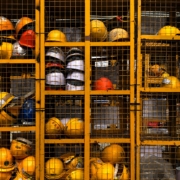One of the main parts of a solid safety program is to promote better communication between employees and management. We believe safety committees are one of the most cost effective, high yielding solutions for safety challenged organizations. Hopefully we can make a case for your organization to start one even if educations hasn’t yet become expensive. Here are some considerations when starting a safety committee.
A well-developed safety committee serves as a two-way channel of communication promoting safety awareness keeping safety top of mind and to better improve operations protocols which will lead to better efficiencies and outcomes throughout the workplace which complete the virtuous circle of lowering costs and engaging your employees.
This article will focus on considerations when starting a safety committee, how to sell the idea to management and who to invite. This will be one of 3 articles on starting a safety committee.
Selling Management On Starting A Safety Committee :
Contingent on your role in the organization whether it be safety manager, supervisor, C.F.O. , HR Director your goals are the same. Safety pays huge dividends in terms of costs, productivity, and quality. We always found it extremely helpful when consulting with upper management to speak in the language they understand best; COST ! Our first objective is to study historical data to dollarize the problem for management as that is what they understand best. Chances are if you are reading this and thinking of building a safety committee something is driving that. That something is usually employee injury claims.
There is a great tool OSHA has that helps businesses understand the high cost of employee injuries. It’s called SAFETY PAYS. Here are some other considerations:
- Order all loss runs for all lines of insurance over the last 5 years and execute a loss pic. This is a profitability ratio correlating the insurance premiums paid in versus claims incurred. Anything over 50% you’re getting surcharged on that particular line of insurance.
- What’s your EMR (Experience Modification Rating on your workers compensation policy. If it’ 1.00 or higher your at a competitive disadvantage to your toughest peers and competitors. Know what the lowest possible modification factor is for your business and set that as a goal. The difference between the lowest EMR and your EMR is an opportunity cost.
- How much does your company spend in fines, legal fees and deductibles over the last 3 to 5 years? That’s money and resources that could be utilized elsewhere.
I think you get where we are going. Once you can demonstrate to management what your cost over runs are you will have their attention. Their next question SHOULD be, what do you suggest? If it’s not you’re probably at the wrong company as they are chasing the wrong rabbit, which is usually top line growth at the expense of healthy profit. If you need help dollarizing your challenge, contact a Risk Advisor at our number 914-357-8444, or visit our website at the link found here. We make the business case for safety to corporate boards and C suite everyday, and we are happy to help with this challenge at no cost to you.
SAFETY COMMITTEE APPROVED! NOW WHAT? :
Careful what you wish for, right? No worries, trying something is better than keep getting a punch in the face of your P&L.
START HERE :
-
Build a list of potential employees that have the following characteristics.
- High achievers / Over achievers.
- Leaders in their peer group, or at least well respected.
- Line employees and not supervisors (more on this later).
- Could or should be recognized.
- Rotate membership so that members exposed to Safety & Health Committee issues are “circulated” back into the workforce and others are brought in. Always have it merit-based as you want folks to aspire to be on the committee.
-
Make a splashy announcement.
Make it so an invitation to this committee is a privilege and recognition for good work, attendance, attitude whatever you find important. This accomplishes two things. It rewards and recognizes the folks that are your high valued employees. Further, it should motivate the folks that were not selected to make the list next time. We also suggest that gift cards, time off, or some other low-cost rewards accompany membership to the committee. It doesn’t have to be big, just something like an exchange of value for their input.
-
Be smart about when you set the meetings.
Be cognizant of their schedules and your workflow needs. Meetings should be fairly short and concise. They should also not be too often. You could start once a month to get some traction then go to quarterly once you feel like you’re in a groove. We find the optimal time is once every month or two months.
-
Build structure around the meetings.
Open with a review of last meetings pending, open up to new incidents or items that have come to the companies attention. Have some great questions for the participants. Have reports and K.R.I’s to review so we can track progress. What’s critical here is that your role is to be facilitator NOT to call these folks in the room to hear you tell them what you think. Draw them out. There are no bad ideas…thank everyone for sharing. Recognize their ideas and opinions as everyone wants acknoledgement. Be positive, emphasize pockets of success. Treat failings and opportunities for improvements.
-
There is great free software to help you organize and structure your meetings and committees.
We suggest a tool like ASANA. It’s fabulously collaborative and FREE. It’s so important to be succinct and efficient in your meetings and to set up action plans and delegate task items to members for the next meeting. One of the reasons a lot of committees fail is there is no follow up, action plan or loop closure. This becomes obvious to everyone that no progress is being made. Having a tool like Asana that helps everyone stay on point and moving forward is critical.
Some Additional Safety Committee Considerations :
- Conduct Safety/Housekeeping inspection(s) of one or more departments as part of each meeting.
- Review and update safety rules and safe operating procedures.
- Review accidents and “near miss” incidents reported since the last meeting. Suggest means for preventing future occurrences using the % Why’s.
- Convey, review and comment on safety suggestions submitted by Employees (pick top 3 to install)
- Create, Plan and carry out various safety promotion activities (such as contests, award programs, etc.) consistent with your goals.
- Create & promote safety awareness among all employees through safe attitudes and day-to-day interactions.
- Review the safety impacts of equipment/facility changes and multi-shift operations.
- Track previous initiatives to find pockets of success to expand on. Lose the initiatives that aren’t achieving your goals to prevent mission creep.
- Take great notes, assign tasks and follow up on tasks completed for the next meeting. Log the minutes somewhere and make sure to share with senior management and other committee members. This is important work and is an organization imperative. Not sharing the minutes puts the committee and it’s work out in left field. Instead, management should emphasize and back it. Nothing could be worse than management either not being aware of the committee’s suggestions or worse. Glossing over their suggestions and implementing nothing. That is despondent leading ultimately to frustration and committee failure. If senior management is not fully committed to the backing and supporting the safety committee everyone is wasting their time.
Our next article in the series focuses on building the right K.R.I’s and other tools to help guide your important work. If you have suggestions for us on this article you may email directly at info@metropolitanrisk.com. Put in the subject line “Safety Committee Article 1”. We hope you found this article helpful.









